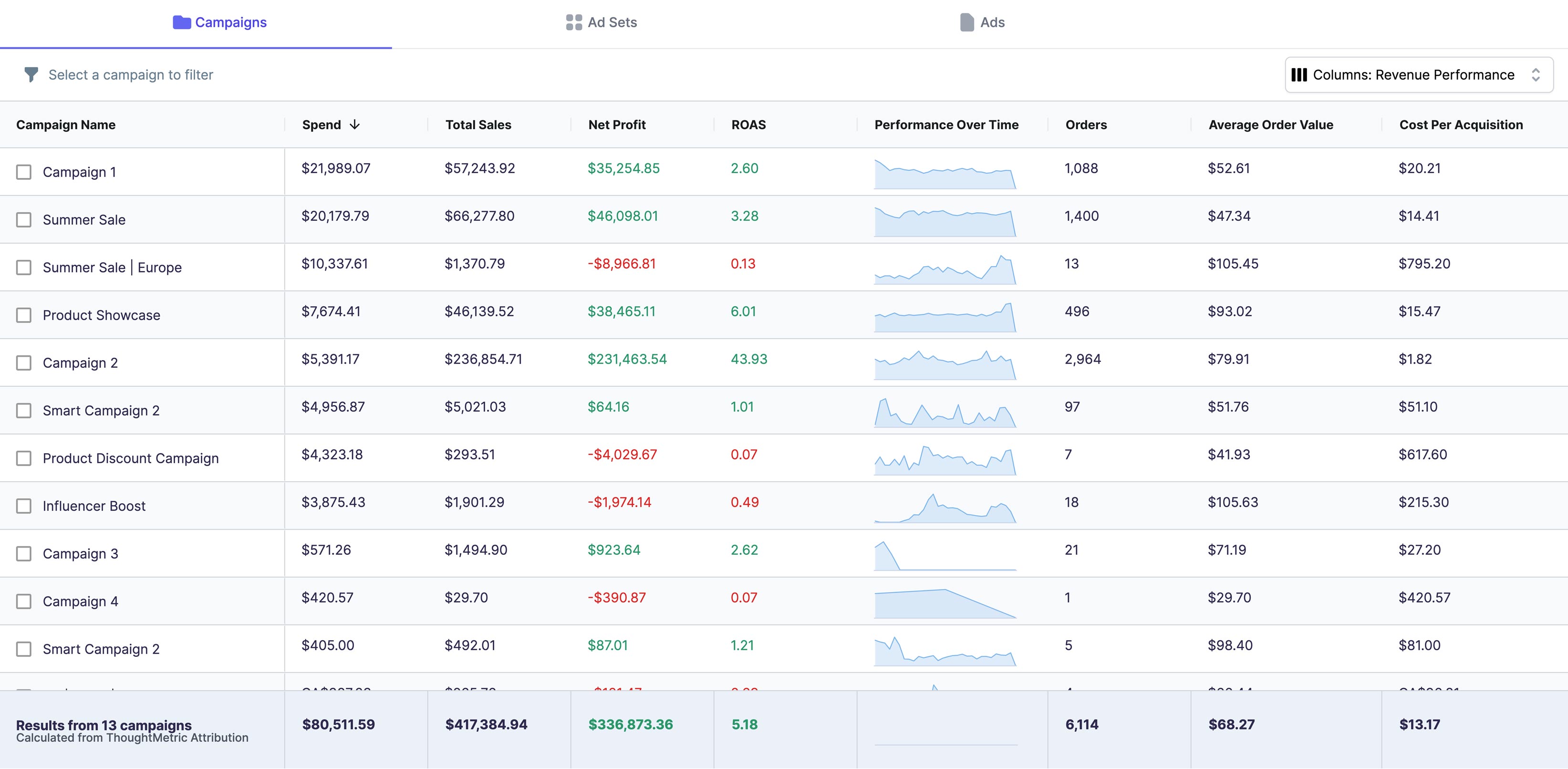For businesses advertising on Facebook, measuring revenue is a crucial part of evaluating advertising efficacy and success. To accurately calculate revenue, it’s important to know which metrics to consider and understand how to navigate Facebook Ads Manager's interface. Here is a comprehensive guide to calculating revenue in Facebook Ads Manager.
Understanding Facebook Ads Manager Metrics
Facebook Ads Manager is an essential tool for businesses to track the performance of their Facebook ad campaigns. With several metrics available to evaluate the revenue generated by Facebook ads campaigns, businesses can make informed decisions to optimize their ad campaigns and increase their return on investment (ROI).
One of the most critical metrics to track is impressions, which refers to the number of times an ad was shown to Facebook users. The more impressions an ad receives, the more likely it is to generate clicks and conversions. Clicks are another essential metric, indicating the number of clicks on an ad leading to the advertiser's destination page. The click-through rate (CTR) is the percentage of impressions that resulted in clicks, and it is a valuable metric to evaluate the effectiveness of an ad campaign.
Conversions are the ultimate goal of any ad campaign, and businesses can track the number of times a conversion event (purchase, registration, or other) occurred after a user clicked on the ad. The cost per click (CPC) is the amount the advertiser pays each time a user clicks on an ad, while the cost per action (CPA) is the average cost to achieve a specific conversion event.
Key Metrics to Track for Revenue Calculation
When calculating revenue, businesses should focus on the following key metrics that are directly related to sales:
- ROAS (Return on Ad Spend): The ratio of revenue generated to the cost of the ad campaign. A ROAS of 2 means that for every $1 spent on advertising, $2 in revenue was generated. This metric is crucial for businesses to evaluate the effectiveness of their ad campaigns and make informed decisions to optimize their ROI.
- Total Revenue: The amount of revenue generated by the ad campaign. This metric can be measured by tracking sales through website conversions, revenue events, catalog sales, or any other designated conversion event on the Facebook pixel. By tracking total revenue, businesses can evaluate the success of their ad campaigns and adjust their strategies accordingly.
- Conversion Value: The total value generated from conversion events, such as purchases, registrations, or leads. This metric is essential for businesses to evaluate the effectiveness of their ad campaigns and make informed decisions to optimize their ROI.
Navigating the Facebook Ads Manager Interface
Navigating the Facebook Ads Manager interface is easy and intuitive. To access Ads Manager, click on the “Ads Manager” button on your Facebook business page’s navigation bar. The Ads Manager dashboard displays your account summary, ad performance, and campaign progress, providing you with valuable insights into the performance of your ad campaigns.
Within each campaign, you can create individual ad sets. The ad set dashboard displays performance for each ad set, along with detailed metrics such as impressions, clicks, and conversion rates. By monitoring these metrics, businesses can make informed decisions to optimize their ad campaigns and increase their ROI.
Setting Up Conversion Tracking
In order to track conversions, you will need to set up conversion tracking through the Facebook Pixel, which tracks user activity on your website. Follow these steps to set up conversion tracking:
Installing the Facebook Pixel
- Go to your Ads Manager and select the “Pixels” tab in the “Assets” section. Click on “Create a Pixel.”
- To install the pixel, you will need to add the pixel code to your website's header. Choose your option of installation (manually or using one of the integration tools).
- Select the specific events you’d like to track, such as purchase activity or add to cart activity.
Configuring Custom Conversions
Custom conversions allow you to track actions on your website that aren’t automatically tracked through the Facebook Pixel. Here’s how to configure custom conversions:
- Navigate to the “Custom Conversions” page under the “Pixels” tab in Ads Manager.
- Click on “Create Custom Conversion.”
- Fill in the details for the custom conversion event that you want to track (such as page views or button clicks).
Tracking Revenue from Specific Products or Services
Facebook allows businesses to track and analyze revenue based on specific products or services. To track revenue by individual product:
- Create a Product Catalog in Facebook Business Manager.
- Include a unique identifier for each product and upload this catalog to Facebook.
- In Ads Manager, select “Catalog Sales” as your objective and then select the specific catalog you’d like to use.
Analyzing Revenue Performance
Analyzing the performance of your Facebook ads campaigns is essential to understanding how to optimize your advertising strategy. Here are some key ways to analyze revenue performance.
Evaluating Campaign Performance
To evaluate campaign performance, select “Campaigns” within the main Ads Manager dashboard. This will give you a high-level view of your campaigns, including spending, reach, and conversion rates. It’s important to analyze this data regularly to determine which campaigns are driving the highest amount of revenue.
When evaluating campaign performance, it’s important to consider the overall return on ad spend (ROAS) for each campaign. This metric is a key indicator of how much revenue your campaigns are generating compared to the amount of money you’re spending on them. If a campaign has a high ROAS, it means that you’re generating more revenue per dollar spent on advertising, which is a good sign that the campaign is performing well.
Another important factor to consider when evaluating campaign performance is the overall cost per acquisition (CPA) for each campaign. This metric measures how much it costs to acquire a new customer through your advertising efforts. If a campaign has a high CPA, it means that you’re spending a lot of money to acquire new customers, which can eat into your profit margins and make it difficult to scale your advertising efforts.
Identifying High-Performing Ad Sets and Ads
Once you’ve evaluated your campaigns, it’s time to dive deeper into your ad sets and individual ads to identify which ones are driving the most revenue. To do this, go to the ad set dashboard and look for ad sets or ads with high conversion rates or ROAS.
When evaluating ad sets and individual ads, it’s important to consider the targeting and messaging used in each one. Ads that are targeted to the right audience and feature compelling messaging are more likely to drive conversions and generate revenue.
Consider allocating a higher budget to these high-performing ads to maximize revenue. By focusing your advertising spend on the ad sets and ads that are driving the most revenue, you can optimize your advertising strategy and improve your overall return on investment (ROI).
Monitoring Return on Ad Spend (ROAS)
ROAS is a key metric for evaluating revenue performance and is calculated by dividing revenue generated by ad spend. Creating ROAS benchmarks allows you to understand which campaigns or ad sets are driving the most revenue and determine where to allocate your budget.
When monitoring ROAS, it’s important to consider the lifetime value (LTV) of your customers. If you’re acquiring new customers through your advertising efforts, it’s important to consider the long-term revenue potential of those customers. By focusing on campaigns and ad sets that generate high LTV customers, you can improve your overall revenue performance and maximize your advertising ROI.
In conclusion, analyzing revenue performance is essential to optimizing your Facebook advertising strategy. By evaluating your campaigns, identifying high-performing ad sets and ads, and monitoring your ROAS, you can improve your overall revenue performance and drive more revenue from your advertising efforts.
Optimizing Your Facebook Ads for Increased Revenue
To optimize your Facebook ads for increased revenue, consider using the following strategies:
A/B Testing Ad Creatives and Targeting
Creating multiple variations of ads and targeting options allows you to determine which combinations are driving the most revenue. Use this data to refine your advertising strategy.
Adjusting Bidding Strategies
Adjusting bidding strategies can help you optimize campaigns to drive revenue while minimizing ad spend. Consider experimenting with different bidding strategies to determine which is the most effective for your business.
Scaling Successful Campaigns
Scaling successful campaigns involves increasing the ad spend and targeting options to maximize revenue. When scaling campaigns, monitor ROAS and other key metrics to avoid overspending.
Conclusion
Calculating revenue generated from Facebook ads campaigns requires an understanding of key metrics, conversion tracking, and data analysis. With this guide, businesses can optimize their advertising strategy to drive increased revenue and improve overall performance on the platform.





